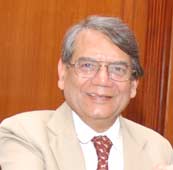Declining trend in GDP growth reversed: RBI
11 May 2009
The measures taken by the Reserve Bank of India and the central government has helped arrest the rate of decline in the economy and rein in inflation, the central bank said in its annual policy statement, even as it estimated GDP growth for 2008-09 at 6.5 to 6.7 per cent.
Recent data, however, indicate that dampened demand has dented corporate margins and that the demand for bank credit has slackened despite comfortable liquidity in the system, showing that the uncertainty surrounding the crisis has affected business confidence, RBI said in its annual bulletin.
 ''The current liquidity surplus in the banking system was not structural,'' Rakesh Mohan, a deputy governor of the RBI, said.
''The current liquidity surplus in the banking system was not structural,'' Rakesh Mohan, a deputy governor of the RBI, said.
''Both the government and the Reserve Bank responded to the challenge of minimising the impact of crisis on India in co-ordination and consultation. The Reserve Bank shifted its policy stance from monetary tightening in response to the elevated inflationary pressures in the first half of 2008-09 to monetary easing in response to easing inflationary pressures and moderation of growth engendered by the crisis,'' the RBI said in its annual bulletin.
RBI said the policy response was aimed at containing the contagion from the global financial crisis while maintaining comfortable domestic and forex liquidity, adding, that most banks too have reduced their deposit and lending rates.
The central government also launched three fiscal stimulus packages during December 2008-February 2009. These stimulus packages came on top of an already announced expanded safety-net programme for the rural poor, the farm loan waiver package and payout following the Sixth Pay Commission report, all of which too added to stimulating demand, RBI noted.
The RBI said its annual policy statement for 2009-10 has been set in the context of exceptionally challenging circumstances in the global economy. The crisis has called into question several fundamental assumptions and beliefs governing economic resilience and financial stability.
''After clocking annual growth of 8.9 per cent on an average over the last five years (2003-08), India was headed for a cyclical downturn in 2008-09. But the growth moderation has been much sharper because of the negative impact of the crisis. In fact, in the first two quarters of 2008-09, the growth slowdown was quite modest; the full impact of the crisis began to be felt post-Lehman in the third quarter, which recorded a sharp downturn in growth, RBI said.
''The services sector, which has been our prime growth engine for the last five years, is slowing, mainly in construction, transport and communication, trade, hotels and restaurants sub-sectors. For the first time in seven years, exports have declined in absolute terms for five months in a row during October 2008-February 2009.'' it noted.
The index of industrial production (IIP) has been nearly stagnant in the last five months (October 2008 to February 2009), of which two months registered negative.
Like all emerging economies, India too has been impacted by the global economic crisis despite its healthy financial sector and no direct exposure to tainted assets, and by much more than what was expected earlier, RBI said.
However, RBI said, there are several comforting factors that have helped India weather the crisis. First, our financial markets, particularly our banks, have continued to function normally. Second, India's comfortable foreign exchange reserves provide confidence in our ability to manage our balance of payments notwithstanding lower export demand and dampened capital flows. Third, headline inflation, as measured by the wholesale price index (WPI), has declined sharply. Consumer price inflation too has begun to moderate. Fourth, because of mandated agricultural lending and social safety-net programmes, rural demand continues to be robust.






























